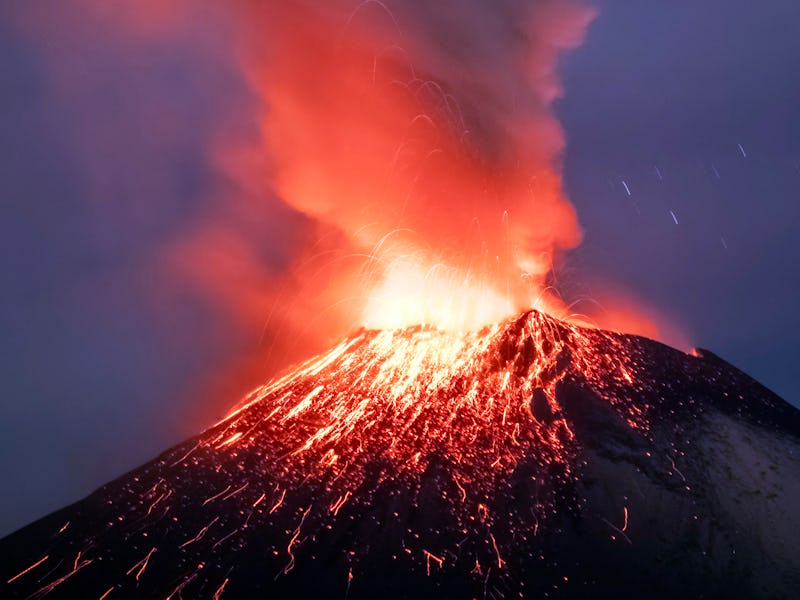Volcanoes and Meteors Helped Produce the Building Blocks of Life on Early Earth
Iron from volcanic ash and dusty meteor debris may have played a role in building complex organic molecules that eventually became building blocks for life.

Some of the most violently destructive forces of nature may have helped assemble the building blocks of life.
To build a living cell, you need some pretty complex molecules: things like carbohydrates, lipids, amino acids, and DNA. And to get those building blocks, you need to start with slightly smaller, simpler building blocks like hydrocarbons, alcohols, and a class of chemicals that includes formaldehyde.
The fact that we exist is proof that at some point, much simpler molecules like carbon dioxide, hydrogen, and water went through a series of chemical reactions to form those early building blocks. In a recent experiment, Ludwig Maximilian University of Munich chemist Sophia Peters and her colleagues found that those reactions could have been kickstarted by microscopic bits of iron-rich dust from volcanic explosions and meteorite impacts. They published their work in the journal Scientific Reports.
Iron-rich particles in the ash spewed out of erupting volcanoes on the early Earth, more than four billion years ago, helped catalyze reactions that turned carbon dioxide and hydrogen into more complex molecules, according to a recent study.
Life: Some Assembly Required
Trapp and his colleagues built a tiny model of the atmosphere on Earth about 4.4 billion years ago by filling a heated, pressurized container with carbon dioxide gas. They added a little water or hydrogen gas to simulate different amounts of moisture in the air, and sprinkled in some ground-up dust to simulate the minerals found in Earth’s newly-formed crust.
So far, scientists who study the origins of life on Earth aren’t sure exactly how, or when, the building blocks of life arrived on the surface of the early Earth.
Some argue that chemical reactions here on the planet helped turn the mix of chemicals in Peters and her colleagues’ pressure cooker (mostly carbon, oxygen, and hydrogen, with a bit of things like silicon and manganese) into the more complex ingredients for life. Others contend that life’s ingredients might have already existed in the cloud of rock, dust, and gas orbiting the Sun, and they arrived on Earth courtesy of a steady bombardment of meteors and comets — or coalesced out of the dust cloud around the newborn Sun along with our planet itself.
Recent evidence shows that planetary systems may be born a starter pack of the more complex chemicals you need to start building the chemistry of life. Peters and her colleagues, however, aren’t convinced that those complex molecules could survive crashing through the primordial Earth’s thick atmosphere aboard a meteor. They wanted to investigate a home-grown recipe for the molecules that would eventually become life’s building blocks.
Meteors and comets wreaked epic havoc on the surface of the early Earth, but particles of iron-rich dust from those crashing space rocks may also have helped kickstart the chain of chemical reactions that eventually led to life.
Homebrewed Biochemistry
Peters and her colleagues sprinkled finely-ground bits of iron meteorites and volcanic ash into their early Earth model.
The addition of iron catalyzed various chemical reactions, leading the ingredients inside to form alcohols and hydrocarbons, essential in organic chemistry. (Or, as co-author Oliver Trapp put it, “versatile organic building blocks.”)
Other studies have explored the idea that energy from lightning or volcanic eruptions on early Earth may have helped power the chemical reactions that broke apart those molecules and reassembled them into more complex ones. Those reactions could also have happened around hydrothermal vents deep in Earth’s newly-condensed oceans.
“There are for sure various sources available,” Trapp, an astronomer at LMU Munich, tells Inverse. “However, we can show that this process is so efficient that it takes only a few millions of years to clear the atmosphere from CO2 and transform all CO2 into organics, which can further react.”
Based on the rate at which those reactions happened in their lab model of early Earth, Peters and her colleagues say these reactions could have cranked out 600,000 tons a year of organic precursors across the surface of the planet. And that, Peters and her colleagues suggest, wouldn’t leave much elbow room (or much need) for other ways of kickstarting those chemical reactions.
If they’re right, that could be good news for scientists looking for life on other rocky worlds orbiting other stars.
“The early Earth and similar young rocky exoplanets could be regarded as a giant catalytic reactor converting feedstock atmospheric gases into complex prebiotic organic matter,” Peters and her colleagues write.